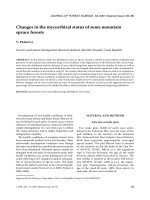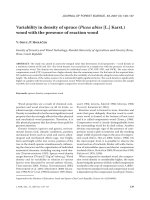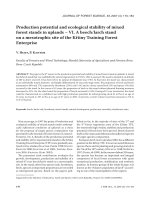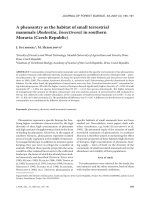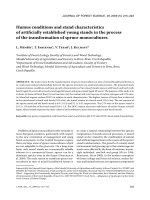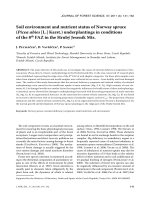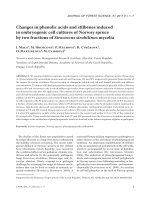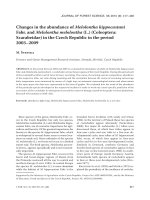Báo cáo lâm nghiệp:"Decline in relative growth rate of 3 juvenile radiata pine clones subjected to varying competition levels in Canterbury, New Zealand" pptx
Bạn đang xem bản rút gọn của tài liệu. Xem và tải ngay bản đầy đủ của tài liệu tại đây (356.45 KB, 7 trang )
585
Ann. For. Sci. 60 (2003) 585–591
© INRA, EDP Sciences, 2004
DOI: 10.1051/forest:2003050
Original article
Decline in relative growth rate of 3 juvenile radiata pine clones
subjected to varying competition levels in Canterbury, New Zealand
Balozi B. KIRONGO
a
*, Euan G. MASON
b
a
Research Scientist at the Kenya Forestry Research Institute (KEFRI), Gede Regional Research Centre, PO Box 201, Malindi, Kenya
b
Associate Professor, School of Forestry, University of Canterbury, Private Bag 4800, Christchurch, New Zealand
(Received 24 June 2002; accepted 7 August 2003)
Abstract – Relative growth rate (RGR) is the ratio of growth to size at the beginning of the growth period. The assumption that RGR is constant,
has been the subject of debate for a long time. In this study, the changes in mean RGR ( ) of 3 clones of Pinus radiata D. Don, grown
under varying weed competition levels (complete weeding, weeding of 2 m diameter circles, weeding of 1 m diameter circles, and no weeding),
were quantified for 3 consecutive years. was calculated each winter, using the morphological and physiological characteristics of RGR
change which quantified as follows:
where: LA = leaf area, Lw = leaf weight, W = dry weight of the plant, SLA = specific leaf area, i.e. the ratio of area and leaf weight, LWR = leaf
weight ratio, i.e. the ratio of total leaf weight of the plant and the total dry weight of the plant, T = time (age), ULR = unit leaf rate. The results
showed that the unweeded control treatment had the lowest absolute RGR. declined with time and tree size in all the weeded treatments, but
increased in the control. The theory that is constant (RGR = k model) is shown to be false, as it varies with both time and tree size. Changes
in during the period studied were best described by an exponential decay function: . Clonal differences were
also demonstrated: clone 3 showed a lower RGR than the other two clones. This was due to the increased LWR and LAR, leaf area ratio (SLA ×
LWR) of this clone. The main reason for mean RGR decline were: (1) reduced ULR with age and size of the plants, (2) changes in allometry and
(3) physiological aging which might have accentuated self shading effects. Tree size influenced RGR changes more than age. This study aims to
dispel the notion of a constant RGR, and at the same time explains the reasons for the decline o this parameter in young trees.
RGR / clones / weeding / LAR / ULR
Résumé – Baisse du taux de croissance relative de 3 jeunes clones de pin radiata soumis à divers niveaux de compétition, à Canterbury,
Nouvelle Zélande. Le taux de croissance relative (RGR) est le rapport entre la croissance et la taille en début de période de croissance.
L’hypothèse selon laquelle RGR serait constant a été l’objet depuis longtemps de débats dans divers endroits. Dans cette étude, on a quantifié,
pendant 3 années consécutives, les variations de RGR moyen ( ) de 3 clones de Pinus radiata D. Don soumis à divers niveaux de
compétition (désherbage complet, désherbage d’un cercle de 2 m de diamètre, désherbage de 1 m de diamètre, pas de désherbage). a été
calculé, chaque hiver, à partir de caractéristiques morphologiques et physiologiques de l’évolution du RGR, qui ont été quantifiées comme suit :
LA = surface foliaire totale du plant, Lw = biomasse foliaire totale du plant, W = biomasse totale du plant, SLA = surface foliaire spécifique,
c’est-à-dire rapport entre la surface et la biomasse des feuilles, LWR = rapport de biomasse foliaire, c’est-à-dire rapport entre la biomasse
foliaire totale du plant et la biomasse totale du plant, T = âge, ULR = efficience folaire unitaire, c’est-à-dire accroissement en biomasse totale
du plant rapporté à la surface foliaire. Les résultats obtenus montrent que le RGR est le moins élevé en valeur absolue pour le traitement témoin
sans désherbage. diminue dans le temps et avec la hauteur des arbres dans tous les traitements avec désherbage alors qu’il augmente pour
le témoin. L’hypothèse d’un constant (RGR = k modèle) est mise en défaut car il varie dans le temps et avec la hauteur des arbres.
L’évolution de pendant la période en cause est mieux décrite par une fonction exponentielle décroissante: .
On a mis en évidence des différences d’évolution de RGR selon les clones, le clone 3 présentant un RGR inférieur à celui des deux autres. Ceci
est dû à une valeur supérieure de LWR et de LAR (SLA × LWR) de ce clone. Les principales raisons de la baisse du RGR moyen sont :
(1) décroissance de ULR avec l’âge et la taille des plants, (2) changements allométriques, (3) vieillissement physiologique pouvant accentuer
les effets d’auto-ombrage. La taille des arbres joue un rôle plus important que l’âge sur les changements de RGR. Cette étude contribue à
supprimer la notion d’un RGR constant tout en fournissant les raisons expliquant la baisse de ce paramètre chez les jeunes arbres.
RGR / clones / désherbage / LAR / ULR
*
Corresponding author: ,
RGR
RGR
RGR
dW
dT
1
LA
×
LA
Lw
×
Lw
W
×=
{
{
{
ULR SLA LWR
RGR
RGR
RGR
RGR
ab+ cW–()exp×=
RGR
RGR
RGR
dW
dT
1
LA
×
LA
Lw
×
Lw
W
×=
{
{
{
ULR SLA LWR
RGR
RGR
RGR
RGR
ab+ cW–()exp×=
586 B.B. Kirongo, E.G. Mason
1. INTRODUCTION
Research in plant growth analysis, especially the approaches
of estimating plant production efficiency, and the effects of
plant size on dry matter production efficiency, i.e. relative
growth rate (RGR), has interested growth analysts for a long
time. Relative growth rate [3] or efficiency index [2] is defined
as the “ratio of growth of an organism to its initial size” [7, 9,
11] i.e.
.(1)
Based on the assumption that growth is directly propor-
tional to size:
, (2)
the equation implies an exponential size-age relationship:
, (3)
where, W = plant dry weight, T = age and k is a constant.
Mason et al. [17] argued that the equation (3) was unsuita-
ble for use in young, “free growing” trees due to its inflexibil-
ity, while South [21] found that it rarely described actual tree
growth data. Mason et al. [17] suggested that functions, which
allowed RGR to vary with both time and tree size, were more
rational. South [21] further reported that even where growth
was exponential, initial size had to be set to zero to give con-
stant RGR, an unlikely event in real life. He gave several
examples of seedlings growing according to the same general
curve but with different initial sizes ending up with different
RGRs. This implied that the morphological and physiological
states of the seedlings influenced their RGR, especially
through effects on dry matter production rates. This is sup-
ported by others e.g. Menzies et al. [19] and Beets and Pollock
[1] who reported chronological age to be of little importance
compared to physiological age in determining dry matter accu-
mulation.
Over the decades several researchers have used mean rela-
tive growth rate as an approximation of plant dry matter pro-
duction efficiency [6, 9, 11, 14, 25]. Other researchers have
used it to remove size-related differences [7, 11, 23]. How-
ever, the biological reasons for constant RGR and/or use of
RGR to remove size-related differences have been questioned
[4, 5, 17, 21, 22]. For example, Britt et al. [4] revealed that
mean RGR did not remove size-related differences. They sug-
gested that mean RGR be compared on an initial size basis
rather than at equivalent ages.
Reported decreases in RGR with plant size have been
attributed mainly to increases in structural material of little
photosynthetic value [1], changes in allometry, especially self-
shading [4] and physiological ageing [19]. Blackman [2] sug-
gested that RGR would remain constant provided that unit leaf
rate (ULR) and leaf area ratio (LAR) remained constant. Unit
leaf rate [3] or net assimilation ratio [10] is defined as the “rate
of dry matter increase per unit leaf area”, i.e. [9]
.
(4)
LAR on the other hand, is defined as the “ratio of total tree
leaf area to total tree dry weight”; i.e. [9]
,(5)
where, LA = leaf area, Lw = leaf weight, W = plant dry weight,
SLA = specific leaf area which is the ratio of leaf area to leaf
weight, while LWR = leaf weight ratio and is defined as the
ratio of total plant foliage weight to plant dry weight.
The mean RGR equation [9], has the disadvantage that it
does not delve in to the possible physiological and morpholog-
ical determinants of growth. Evans [9] used an expansion form
of the equation to include LA, Lw and W; thus:
;(6)
i.e.
(7)
because LAR = SLA × LWR (see Eq. (5)).
In this study the changes in mean RGR of 3 clones of radi-
ata pine growing in four varying competition levels were eval-
uated for 3 years by quantifying the physiological and mor-
phological changes using the RGR expansion (Eq. (6)) with
the following main objectives:
1. to show which of the postulates for constant RGR (i.e. con-
stant ULR and constant LAR) were breached;
2. to model the variation in RGR with time and tree size using
the RGR = k model and models allowing for changes in tree
size and age;
3. to study the effects of varying competition levels and the
effects of genotype on mean RGR.
2. MATERIALS AND METHODS
This study was set up in September 1996 in Dunsandel, a dry site
on the Canterbury plains, New Zealand. It was a competition-by-gen-
otype experiment. Average annual rainfall at the site was 600 mm.
The main weed species were remnants of pasture especially white
clover (Trifolium repens), sorrel (Rumex acetosella) and Italian rye
grass (Lolium multiflorum). During the 2nd growing season there was
a severe drought.
2.1. Experimental design and layout
The experiment was designed in randomized complete blocks and
laid out in split-plots in 3 replications. Trees were planted at nominal
spacings of 3 × 3 m. Weeding treatments formed the main plots while
3 (out of a possible 7) clones were the sub-plots. The weeding treat-
ments were:
1. complete weeding equivalent to 9 m
2
(Wc9) of weed-free area
around each tree;
2. 2 m diameter circular weed-free spots equivalent to 3.14 m
2
(Wc3);
3. 1 m diameter spots equivalent to 0.75 m
2
weed-free area (Wc0.75)
around each tree;
4. a control (Wc0.03) which received 0.03 m
2
weed-free area (20 cm
diameter spots) only at time of planting.
RGR
dW
dT
1
W
×=
dW
dT
kW×=
WkT×()exp=
ULR
dW
dT
1
LA
×=
LAR
LA
Lw
Lw
W
×
LA
W
==
{
{
SLA LWR
RGR
dW
dT
1
LA
×
LA
Lw
×
Lw
W
×=
{
{
{
ULR SLA LWR
RGR SLA LWR×=
Reasons for relative growth rate decline of juvenile trees 587
The three clones (designated Cl1, Cl2 and Cl3 henceforth) used in
the study were clone 1 (slowest grower of the seven clones in year 1),
clone 2 (intermediate growth) and clone 3 (fastest growing of the
seven clones in year 1). Main plots were planted with 70 seedlings in
7 lines of 10 trees of each clone. One row of surround received similar
weeding treatments as the main plots. Weed control was achieved
using a mixture of herbicides; terbuthylazine (7.5 kg active ingredi-
ents, a.i.), haloxyfop (300 g a.i.) and clopyralid (900 g a.i.) all dis-
solved together in 250 litres of water to the hectare. Subsequent weed
control was done whenever necessary. For more information on
materials and methods refer to Mason and Kirongo [16].
2.2. Quantifying terms of the RGR expansion
Relative growth rate was calculated in winter of each year (at ages
1, 2 and 3) by evaluating the terms in the RGR expansion;
(7)
[9], [terms as defined earlier in Eqs. (4) and (5)].
Annual mean Unit leaf rate ( ) was given by;
, (8)
(terms as defined earlier).
This is because:
(9)
Annual mean LAR was calculated thus,
; (10)
where, LA
1
, LA
2
= leaf area of the tree at the start and end of the
study period, and W
1
, W
2
= plant dry weight at the start and end of
the study period respectively.
Destructive sampling of 60 trees in the experiment was carried out
to develop regressions to be used on 360 standing trees in similar
clones and weeding treatments. Photographs of all trees in the exper-
iment were taken at each measurement time using a digital camera
and their areas calculated using Metamorph image analysis [24] as
explained by Kirongo [12], Kirongo et al. [13] and Mason et al. [18].
Regressions of crown areas on photographs vs. total tree biomass
for destructively sampled trees were developed. Another set of
regressions for leaf area (LA) vs. leaf weight (Lw) was developed for
leaf samples collected from different crown parts of the destructively
sampled trees as well as on standing trees [13]. The regressions were
used to estimate standing trees’ total biomass (W), total leaf areas
(LA) [18] and total leaf weight (Lw).
From this information, mean ULR and mean LAR were calcu-
lated. From the computed values the terms of the RGR expansion and
hence the RGR changes by age and tree size were calculated [12].
Total foliage amounts, foliage additions and losses were evaluated
using a combination of image analysis techniques [24] and actual
needle counts on 360 sampling units on 72 sample trees [12]. Esti-
mates of needle mortality [12] were used to adjust for LA losses dur-
ing the growth period, i.e. year 1–2 (= T1) and year 2–3 (= T2). Mean
RGR was also calculated by accounting for carbon fixation potential
as estimated by each leaf-age light use efficiency (light use efficiency
in this context means the proportion of final products of photosynthe-
sis the leaf will produce given same light conditions) [28]. The
weighting procedure was done as follows; one-year old foliage was
given a weighting of 1, two-year old a weighting of 0.70 and three-
year old foliage a weighting of 0.40 [28].
Changes in RGR during the study period were then modelled
using non-linear regression procedure in SAS [20]. The following
equations were fitted to the data:
1. constant RGR model i.e. RGR = k;
2. exponential equations (models) which allowed RGR to change
with size and age:
(11)
derived from
W = exp(aT
b
), (12)
(13)
derived from
W = aT
b
, (14)
and
(15)
an exponential decay function, where: W = plant dry weight, T = time
and a, b, c and k are constants.
3. RESULTS
Mean relative growth rate of individual trees decreased
both with tree age and size for all trees in the weeded treat-
ments (Wc9, Wc3 and Wc0.75). Trees in the control (Wc0.03)
recorded increased RGR with time and size, however (Fig. 1).
RGR increased with increasing weed-free area per tree
(Fig. 2). Clones 1 and 2 had higher RGRs than clone 3 in all
weeded treatments (Fig. 2).
Weighting RGR to account for leaf-age differences and
hence differences in C-fixation abilities led to slight increases
in RGR in clones 1 and 2 but reductions in clone 3 (data not
shown). The constant relative growth rate model, RGR = k,
was biased especially for tree size (Fig. 3).
Allowing RGR to vary with time and tree size gave good fits.
Of the three functions fitted i.e. equations 11, 13 and 15, the
exponential decay function, i.e.
with dummy variables for weeding treatments and clones gave
the best fits to the data. Plots of residuals vs the predicted values
(not shown) and the independent variable (initial tree biomass)
showed no apparent bias (Fig. 4). Using foliage biomass rather
than tree biomass gave similar results (data not shown).
The dummy variables for weeding treatments were signifi-
cant thus; a = a
0
+ a
1
× Wc0.75, b = b
0
+ b
1
× Wc0.03 and c =
c
0
+ c
1
× Wc3. The model outputs for equation 15 are summa-
rized in Table I.
RGR trends plotted using the coefficients (Tab. I) output
from the selected model (Eq. (15)) showed that trees in all
weeded treatments (Wc9, Wc3 and Wc0.75) had a decline in
RGR while those in the unweeded control (Wc0.03) had an
increase in RGR with size (Fig. 5). Moreover, trees in Wc3
had a much faster decline in RGR than trees in Wc9, while
those in Wc0.75 had a lower asymptote in contrast to trees in
RGR ULR LAR×=
ULR
ULR
W
2
W
1
–
T
2
T
1
–
LA
2
()log LA
1
()log–
LA
2
LA
1
–
×=
LA
2
()log LA
1
()log–
LA
2
LA
1
–
dLA()log
dt
dt
dLA()
×=
1
LA
dLA()
dt
×
dt
dLA()
×=
1
LA
=
.
LAR
LA
2
W
2
⁄ LA
1
W
1
⁄+
2
=
RGR W()ln
b
T
×=
RGR
b
T
=
RGR
ab+ c– W×()exp×=
RGR
ab+ c– W×()exp×=
588 B.B. Kirongo, E.G. Mason
all the other treatments (Fig. 5). Weighting for leaf-age differ-
ences in C-fixation resulted in only slight increases in RGR in
all weeding treatments (data not shown).
Clone 3 showed decreases in mean ULR with tree size dur-
ing year 2–3 growth period while clones 1 and 2 showed slight
increases in mean ULR during the same period (data not
shown). Meanwhile, the leaf weight ratio (LWR) increased
with increasing tree size in clone 3 but decreased with size in
clones 1 and 2 (Fig. 6) during the same period. Clone 3 also
showed increased LWR with age and increasing weed-free
area per tree, while the opposite was true for clones 1 and 2
(data not shown).
Leaf area ratio increased with size in clone 3 but decreased
in clones 1 and 2 (data not shown). Further analysis showed
that clone 3 had increased LAR with age and with increasing
weed-free area per tree, while clones 1 and 2 had weak trends
showing decreases in LAR with size and tree age (data not
shown).
Analysis on the possible causes of the decrease in RGR
between year 2–3 season for trees in weeded environments
showed there were decreases of up to 30% in ULR and upto
20% in LAR in some clones (Fig. 7). Meanwhile, trees in
unweeded treatments had higher percentage increases in ULR
(Fig. 7). In particular trees in the unweeded control belonging
to clone 2 had highest percentage increases in RGR (40%
compared to 18% and 25% in clones 3 and 1 respectively).
Trees in the unweeded control had the highest percent change
in mean ULR during the same period; 70% in clone 2, 55% in
clone 1 and 10% in clone 3 (Fig. 7).
Figure 1. Mean relative growth rate ( ) versus initial
tree above ground biomass for trees in all weeding treat-
ments.
RGR
0
0.5
1
1.5
2
2.5
3
Wc9 Wc3 Wc0.75 Wc0.03
Weed free area/tree (m
2
)
Mean RG
R
CL1
CL2
CL3
Figure 2. Unweighted mean relative growth rate of clones 1, 2 and 3
versus weed free area per tree (m
2
) during the third growing season
(age 3).
Figure 3. Plot of residuals by initial tree size (biomass) for
the RGR = k model showing the bias with increasing tree
size.
Reasons for relative growth rate decline of juvenile trees 589
LWR changes during the same period (year 2–3) increased
with increasing competition in clones 1 and 2, but decreased
in clone 3. Trees in clones 1 and 2 in all weeding treatments
had negative changes in LWR during the period year 2–3,
while those in clone 3 had positive increases of between 15–
25% (Fig. 8).
4. DISCUSSION
Relative growth rate decreased with size in all trees grow-
ing in weeded micro-environments and increased in trees in
the unweeded control (Fig. 5). Blackman [2] postulated that
for RGR to be constant ULR and LAR had to be constant with
size. The trees in this study breached both these assumptions
(Fig. 7). During the third growing season trees changed their
LWR (Fig. 8) and their allometric ratios as well. Thus changes
in allometry [4] may have contributed in part to the overall
change in ULR and LAR and hence RGR.
Trees in the unweeded control had lowest RGR at the same
size compared to those in weed free micro-environments. This
may have been due to their low LA and hence photosynthetic
capacities resulting in low LAR and reduced net assimilation
rates. Trees in the control had proportionally more older foli-
age [13] than their counterparts growing in weeded environ-
ments. Old foliage is less efficient in C-fixation [15, 26, 27], a
fact, which could explain in part the low productivity of trees
in the unweeded controls. The weighting of RGR (to account
for leaf age differences in carbon assimilation) showed little
effect. This may suggest that the proportion of old foliage may
be of little importance, an observation needing further study.
The decrease in RGR with time and especially tree size
reported in this study serves to emphasize the observations
made by others (e.g. Mason et al. [17], South [21]) that the
belief of a constant RGR is fallacious. These results further
support the suggestions made by Mason et al. [17] that growth
analysts need to use equations which allow RGR to vary with
tree age and size. The observation that the constant RGR
model was highly biased for tree size (Fig. 3) further supports
suggestions by Britt et al. [4] who postulated that RGR be
compared on initial size basis rather than chronological age.
Mean RGR decreased with tree size and age in all weeded
treatments but not the control. The increase in RGR with size
in the unweeded controls may have been due to:
1. increased ULR with size (Fig. 7);
2. a possible increase in photosynthetic activity during the
third growing season due to favourable weather (weather
data not shown);
Figure 4. Plot of residuals versus predicted mean RGR for the
exponential decay model showing apparent lack of bias.
Table I. Outputs of the exponential decay model fitted to the mean
RGR data.
Number of observations Mean Residual MSE Skewness Kurtosis
515 0.000072 0.085477 –0.23551 0.651321
Coefficients: a0 = 1.73979, a1 = –0.57142, b0 = 0.94012,
b1 = –1.55955, c0 = 0.00132, c1 = 0.00367
Figure 5. RGR trends with increasing initial tree biomass
(g) for each weeding treatment showing increase in RGR
with size for trees in unweeded treatment.
590 B.B. Kirongo, E.G. Mason
3. less self shading as a result of sparse crowns.
By partitioning RGR into ULR and LAR, it was evident
that the reasons for the decline in RGR for trees growing in
weeded treatments were:
1. changes in allometry due to increases in LA in the third
growing season;
2. possible self-shading in the crowns due to increased foliage
amounts;
3. reduced LAR and ULR (Fig. 7);
4. increased proportions of physiologically young foliage
which affected the trees’ physiological age.
Self shading [4] has been said to be one of the causes of
RGR decline in trees. Xu [28] reported significant self-shad-
ing in 5-year old radiata pine clones. However, South [21]
reported RGR decreases in seedlings where self-shading may
have been less important. In this study, the role of self-shading
could not be explicitly determined and further studies on light
conditions within canopies are recommended.
Clone 3 had lower RGR than the other 2 clones in all
weeded environments. This may point to a different growth
and above ground allocation strategy; a point supported by the
increased LAR with size (Fig. 7), increased LWR (Fig. 6) and
low ULR shown in this clone. The decrease in ULR in clone 3
and not in the other 2 clones may also imply that clone 3 spent
more assimilates to nurture the new foliage formed during the
third growing season before the foliage was fully mature and
able to contribute positively to net assimilation [8]. Increased
foliage amounts may also be a disadvantage in dry sites such
as Dunsandell, leading to excessive evapotranspiration.
5. CONCLUSIONS
It is evident from this study therefore, that changes in RGR
were influenced by ULR which depended on both the amounts
-60
-40
-20
0
20
40
60
80
100
RGR
Wc9
ULR LAR RGR
Wc3
ULR LAR RGR
Wc0. 75
ULR LAR RGR
Wc0. 03
ULR LAR
% change .
CL1
CL2
CL3
Figure 6. Mean Leaf weight ratio (LWR) versus initial tree
biomass for clone 1, 2 and 3 showing an increase in LWR
in clone 3 and a decrease in clones 1 and 2.
Figure 7. Percent changes in mean RGR, ULR
and LAR for clones 1, 2 and 3 by increasing
competition between year 2 and 3.
-20
-10
0
10
20
30
40
Wc9 Wc3 Wc0.75 Wc0.03
% change in LWR
CL1
CL2
CL3
F
igure 8. Percent changes in LWR for clones 1, 2 and 3 by increasing
c
ompetition between year 2 and 3.
Reasons for relative growth rate decline of juvenile trees 591
and proportions of the different age classes of foliage on the
crowns. High LAR (or LWR) led to increased RGR only in
cases where ULR was also high. Changes in allometry due to
increased new foliage influenced RGR through their effects on
LA and overall photosynthetically active radiation (PAR) use
efficiency as a result of a possible increase in self-shading.
Changes in tree size were more correlated to changes in RGR
than tree age.
This study showed clearly that the assumption of constant
RGR is flawed. Quantifying the morphological and physiolog-
ical terms of the RGR expansion showed that ULR was the
main factor influencing RGR changes in this study. The main
conclusions drawn were:
1. RGR changed with time and tree size in all treatments with
the latter being more important than age in influencing
RGR changes;
2. RGR decreased in trees in weeded environments but
increased in trees in unweeded control;
3. The RGR = k model was especially biased with tree size. An
exponential decay function,
gave the best fits for the RGR data;
4. ULR was the main factor influencing RGR changes in this
study;
5. Clone 3 had a different growth and above ground allocation
strategy and hence RGR trends to the other 2 clones stud-
ied.
REFERENCES
[1] Beets P.N., Pollock D.S., Accumulation and partitioning of dry
matter in Pinus radiata as related to stand age and thinning, N. Z.
J. For. Sci. 17 (1987) 246–271.
[2] Blackman V.H., The compound interest law and plant growth, Ann.
Bot. 33 (1919) 353–360.
[3] Briggs G.E., Kidd F., West C., A quantative analysis of plant
growth. I. Relative growth curve, Ann. Appl. Biol. 7 (1920) 103–
123.
[4] Britt J.R., Mitchell R.J., Zutter B.R., South D.B., Gjerstad D.H.,
Dickson J.F., The influence of herbaceous weed control and
seedling diameter on six years of Loblolly pine growth – A classical
growth analysis Approach, For. Sci. 37 (1991) 655–668.
[5] Burdon R.D., Sweet G.B., The problem of interpreting inherent
differences in tree growth shortly after planting, in: Cannell M.G.R.
(Ed.), Tree physiology and yield improvement, Academic Press,
London, 1976, pp. 483–502.
[6] Causton D.R., A biologist's basic mathematics, Edward Arnold
Publishers, 1983.
[7] Causton D.R., Venus J.C., The Biometry of plant growth, Edward
Arnold Publishers, 1981.
[8] Dale E.J., The growth of leaves, Studies in Biology, No. 137,
Edward Arnold publishers, 1982.
[9] Evans G.C., The quantitative analysis of plant growth, Blackwell
Scientific publishers, Oxford, 1972.
[10] Gregory F.G., The effect of climatic conditions on the growth of
barley, Ann. Bot. 40 (1926) 1–26.
[11] Hunt R., Plant growth curves: the functional approach to plant
growth analysis, Edward Arnold publishers, 1982.
[12] Kirongo B.B., Modelling growth responses of juvenile radiata pine
(Pinus radiata D. Don) clones subjected to different weed
competition levels in Canterbury, New Zealand, Ph.D. thesis,
University of Canterbury (Christchurch), New Zealand, 2000.
[13] Kirongo B.B., Mason E.G., Nugroho P.A., Interference mecha-
nisms of pasture on the growth and fascicle dynamics of 3-year old
radiata pine clones, For. Ecol. Manage. 159 (2002) 159–172.
[14] Ledig F.T., Perry T.O., Net assimilation rate and growth in loblolly
pine seedlings, For. Sci. 15 (1969) 431–438.
[15] Leverenz J., Deans J.D., Ford E.D., Jarvis P.G., Milne R.,
Whitehead D., Systematic spatial variation of stomatal conductance
in Sitka spruce plantation, J. Appl. Ecol. 19 (1982) 835–851.
[16] Mason E.G., Kirongo B.B., Responses of radiata pine clones to
varying levels of pasture competition in a semiarid environment,
Can. J. For. Res. 29 (1999) 934–939.
[17] Mason E.G., South D.B., Zutter B.R., Classical growth analysis for
a computer age, in: Modelling regeneration success and Early
growth of forest stands, Procs. IUFRO conference, Copenhagen,
Denmark, 1996, pp. 221–230.
[18] Mason E., Kirongo B.B., Watt M.S., Richardson B., Mead D.J., Use
of image analysis to estimate foliage masses of radiata pine clones
and families subjected to varying levels of competition from weeds,
Ann. For. Sci. (submitted).
[19] Menzies M.I., Klomp, B.K., Holden D.G., Optimal physiological
age of propagules for use in Clonal forestry, in: Miller J.T. (Ed.),
Procs. FRI/NZFP Forests Ltd., Clonal forestry workshop 1–2 May
1989, Rotorua, New Zealand, FRI Bulletin No. 160, 1991, pp. 142–
146.
[20] SAS Institute Inc., SAS/STATS, Guide for personal computers,
version 6 Edition, Cary NC., SAS Institute, 1990.
[21] South D.B., Testing the hypothesis that mean relative growth rate
eliminates size related growth differences in tree seedlings, N. Z. J.
For. Sci. 21 (1991) 144–164.
[22] South D.B., Relative growth rates: A critique, South African For. J.
173 (1995) 43–48.
[23] Sweet G.B., Wareing P.F., The relative growth rates of large and
small seedlings in forest tree species, Forestry Supplement, 1966,
pp. 110–117.
[24] Universal Imaging Corporation, Metamorph Imaging system,
Summary guide, Image –1/Metamorph Imaging System, Version 2
for MS windows, Universal Imaging Corporation, USA, 1995.
[25] Van den Driesche P., Van den Driesche R., Growth analysis, in:
Van den Driesche R. (Ed.), Mineral nutrition of Conifer seedlings,
CRC press, Boca Raton, Florida, 1991.
[26] Watts W.R., Neilson R.E., Jarvis P.G., Photosynthesis in Sitka
spruce (Picea sitchensis (Bong) CARR.): VII Measurements of
stomatal conductance and
14
CO
2
uptake in a forest canopy, J. Appl.
Ecol. 13 (1976) 623–638.
[27] Woodman J.N., Variation of net photosynthesis within the crown of
a large forest grown conifer, Photosynthetica 5 (1971) 50–54
(Abstracts).
[28] Xu H., Modelling Photosynthetic CO
2
fixation among radiata pine
clones with contrasting crown characterstics at age 5 at Dalethorpe,
Canterbury, Ph.D. thesis, University of Canterbury, Christchurch,
2000.
RGR
ab+ c– W×()exp×=
